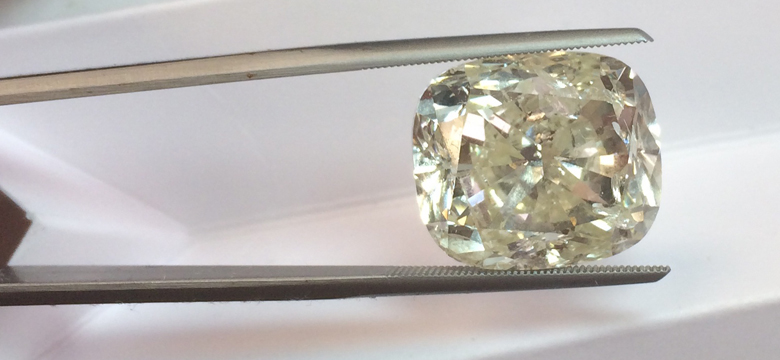A 16.87 carat diamond from the Kelsey Lake Mine in Colorado was sold at auction for $185,000 in 2015.
Buy, Value or Appraise Your Antique and Vintage Jewelry and Gems
Bid or buy antique and vintage estate jewelry and gems for sale, value your item, or request a free appraisal to sell your collection.
Many fantastic diamonds come across my desk to be cataloged and put up for auction. I often wonder about the exotic locales from which they were sourced…India, Brazil, Russia, South Africa (a name synonymous with diamond mining) or perhaps a more recent source, like Australia. I think about the incredible journeys these diamonds have been on prior to visiting us here in the Heritage Fine Jewelry department. Perhaps it was mined in Australia and sent halfway across the world to a cutting center in India or Israel? Or maybe it was found in a marine deposit off Africa’s Atlantic coast and sent to Belgium for polishing, then imported through New York.
Whatever the path may have been, I am confident that the diamond in hand is far better traveled than myself.
This month, however, a diamond has come to visit from an unexpected source much closer to home.
The Kelsey Lake Mine was a small operation in Colorado, up north on the border of Wyoming. It was the second commercial diamond mine in the United States, after the Crater of Diamonds State Park in Arkansas, which is now a popular tourist destination.
Mineralogists first discovered the presence of kimberlite (an igneous rock that sometimes contain diamonds) in the region in 1975, while studying the area’s limestone formations. As they tried to slice through the rock, tools were getting damaged, which could only mean one thing— the presence of the hardest substance on earth—diamond. With the discovery of diamonds, corporate interest in a potential mine grew and financing and equipment flowed into the region. Unfortunately, after a few years of exploration with little yield, that interest faded.
Refusing to give up, one particularly adamant local geologist, Howard G. Coopersmith, took matters into his own hands, and by 1987, his diamond exploration company confirmed the presence of two diamondiferous kimberlite pipes at Kelsey Lake.
A 14.20 carat gem-quality piece of diamond rough was the first big discovery in 1994. Becoming a subsidiary of an international mining firm, the official Kelsey Lake Mine began operating in 1996. A couple months later, two more sizable discoveries—a 28.30 carat fancy yellow diamond and an 11.75 carat gem-quality diamond—were unearthed. “Colorado Diamonds” became a trademark and local dealers had exclusive access. The future of the mine looked promising.
Our visitor, a 16.87 carat cushion-cut, was discovered as a 28.18 carat piece of rough in July of 1997. At the time of cutting, it was the largest polished diamond of North American origin on record. (An account of the diamond’s discovery can be read in the letters imaged below.) Unfortunately, operations at the Kelsey Lake Mine closed in late 1997, after the parent company sold its mining operations to focus on exploration. Sadly, abandonment of mines is a fate well-known in the diamond industry.
Potentially profitable diamond sources are rare, and it is almost always uneconomical to begin the mining process. Considerable financial investments, and years, even decades of research and study go into determining whether starting a mine will be profitable. If mines cannot produce the expected output, they are quickly closed to protect against further losses. A true gamble, there is no guarantee that source will be profitable. All we can do is use our knowledge of the earth and our best judgment and hope to get lucky and find a gem—like the 16.87 carat stone in front of me now.
Although not the finest example of a diamond in either color or clarity, this Kelsey Lake diamond is a true piece of both American and diamond mining history.
Visit our jewelry department to view upcoming auctions and to browse our auction archives
By Caroline Ervin
